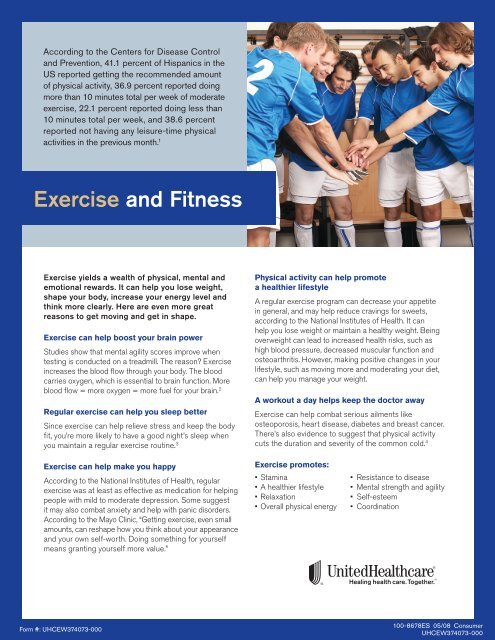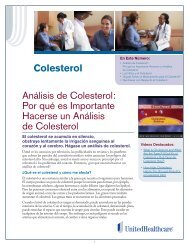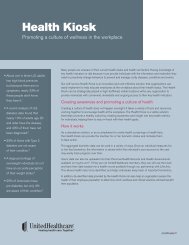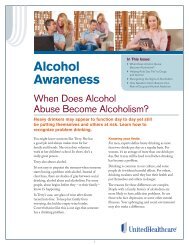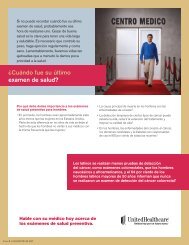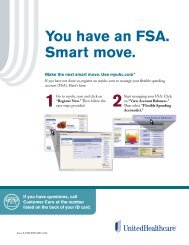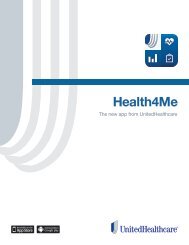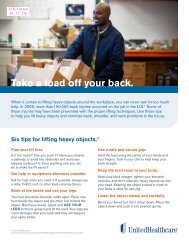Exercise and Fitness Brochure - UHC Tools
Exercise and Fitness Brochure - UHC Tools
Exercise and Fitness Brochure - UHC Tools
You also want an ePaper? Increase the reach of your titles
YUMPU automatically turns print PDFs into web optimized ePapers that Google loves.
According to the Centers for Disease Control<br />
<strong>and</strong> Prevention, 41.1 percent of Hispanics in the<br />
US reported getting the recommended amount<br />
of physical activity, 36.9 percent reported doing<br />
more than 10 minutes total per week of moderate<br />
exercise, 22.1 percent reported doing less than<br />
10 minutes total per week, <strong>and</strong> 38.6 percent<br />
reported not having any leisure-time physical<br />
activities in the previous month. 1<br />
<strong>Exercise</strong> <strong>and</strong> <strong>Fitness</strong><br />
<strong>Exercise</strong> yields a wealth of physical, mental <strong>and</strong><br />
emotional rewards. It can help you lose weight,<br />
shape your body, increase your energy level <strong>and</strong><br />
think more clearly. Here are even more great<br />
reasons to get moving <strong>and</strong> get in shape.<br />
<strong>Exercise</strong> can help boost your brain power<br />
Studies show that mental agility scores improve when<br />
testing is conducted on a treadmill. The reason? <strong>Exercise</strong><br />
increases the blood flow through your body. The blood<br />
carries oxygen, which is essential to brain function. More<br />
blood flow = more oxygen = more fuel for your brain. 2<br />
Regular exercise can help you sleep better<br />
Since exercise can help relieve stress <strong>and</strong> keep the body<br />
fit, you’re more likely to have a good night’s sleep when<br />
you maintain a regular exercise routine. 3<br />
Physical activity can help promote<br />
a healthier lifestyle<br />
A regular exercise program can decrease your appetite<br />
in general, <strong>and</strong> may help reduce cravings for sweets,<br />
according to the National Institutes of Health. It can<br />
help you lose weight or maintain a healthy weight. Being<br />
overweight can lead to increased health risks, such as<br />
high blood pressure, decreased muscular function <strong>and</strong><br />
osteoarthritis. However, making positive changes in your<br />
lifestyle, such as moving more <strong>and</strong> moderating your diet,<br />
can help you manage your weight.<br />
A workout a day helps keep the doctor away<br />
<strong>Exercise</strong> can help combat serious ailments like<br />
osteoporosis, heart disease, diabetes <strong>and</strong> breast cancer.<br />
There’s also evidence to suggest that physical activity<br />
cuts the duration <strong>and</strong> severity of the common cold. 4<br />
<strong>Exercise</strong> can help make you happy<br />
According to the National Institutes of Health, regular<br />
exercise was at least as effective as medication for helping<br />
people with mild to moderate depression. Some suggest<br />
it may also combat anxiety <strong>and</strong> help with panic disorders.<br />
According to the Mayo Clinic, “Getting exercise, even small<br />
amounts, can reshape how you think about your appearance<br />
<strong>and</strong> your own self-worth. Doing something for yourself<br />
means granting yourself more value.”<br />
<strong>Exercise</strong> promotes:<br />
• Stamina<br />
• A healthier lifestyle<br />
• Relaxation<br />
• Overall physical energy<br />
• Resistance to disease<br />
• Mental strength <strong>and</strong> agility<br />
• Self-esteem<br />
• Coordination<br />
Form #: <strong>UHC</strong>EW374073-000<br />
100-8678ES 05/08 Consumer<br />
<strong>UHC</strong>EW374073-000
<strong>Exercise</strong> fights:<br />
• Anxiety<br />
• Stroke<br />
• Diabetes<br />
• Poor health habits<br />
• Depression<br />
• Heart disease<br />
• Stress<br />
Now that you know the benefits of being physically active,<br />
it’s time to think about putting together an exercise program<br />
that works for you. If you have any medical conditions, it may<br />
be good to talk to your doctor before starting a new exercise<br />
program. Then get into it gradually – you don’t want to pull a<br />
muscle or injure a joint. Learn how to warm up <strong>and</strong> do your<br />
exercises in the correct form.<br />
Here is one component of an exercise program that you<br />
might consider to build strength <strong>and</strong> endurance.<br />
Getting strong through resistance training<br />
According to the American Sports Medicine Institute<br />
(ASMI), resistance training – also called weight training or<br />
strength training – is a “specialized method of conditioning<br />
designed to increase muscle strength, muscle endurance<br />
<strong>and</strong> muscle power.” You can train in a number of ways: with<br />
resistance machines, free weights, or by doing pushups,<br />
squats or abdominal crunches. Regular resistance training<br />
will strengthen your bones, build <strong>and</strong> strengthen your<br />
muscles <strong>and</strong> leave your body more toned.<br />
Resistance training can be done almost anywhere. All you<br />
need is a carpeted floor or mat <strong>and</strong> a set of dumbbells or<br />
barbells (or even other weighted objects, such as small<br />
bags of rice, liters of soda, cans of soup, etc.).<br />
Once you begin resistance training, you’ll notice the<br />
advantages during your daily routine. For instance, carrying<br />
your briefcase, doing laundry <strong>and</strong> hauling groceries becomes<br />
much easier when your arm <strong>and</strong> chest muscles are toned.<br />
Any chronic lower back pain may be alleviated through<br />
conditioning your abdominal muscles. Plus, resistance<br />
training can help people maintain better posture.<br />
And if you are trying to lose weight, resistance training can<br />
actually help you burn more calories. The more muscles you<br />
build, the more energy <strong>and</strong> calories your body expends to<br />
maintain those muscles. How many calories you burn in a<br />
resistance training session depends on a variety of factors,<br />
including your weight, the duration of your session, <strong>and</strong> how<br />
vigorously you work your muscle groups.<br />
If you’re beginning resistance training at a gym, consider<br />
working with a nationally certified exercise professional.<br />
If you’re starting at home, be sure to read the instruction<br />
manual before using any equipment.<br />
For more information about health <strong>and</strong> wellness,<br />
please visit UnitedHealthcare’s Latino Health<br />
Solutions SM<br />
at www.uhclatino.com.<br />
Sources:<br />
1<br />
U.S. Physical Activity Statistics: 2005 State Demographic Data Comparison, www.cdc.gov*<br />
2<br />
The Rewards of <strong>Exercise</strong>, Author: Patricia L. Fry*<br />
3<br />
Stress <strong>and</strong> Sleep Issues, www.webmd.com*<br />
4<br />
<strong>Exercise</strong> <strong>and</strong> Overall Well Being, www.nlm.nih.gov*<br />
* UnitedHealthcare is not affiliated with these authors <strong>and</strong> Web sites.<br />
This information was prepared solely for general educational purposes. If you have specific questions about the topic(s) featured in this flier or about other health<br />
conditions, see your doctor.<br />
Insurance coverage provided by or through United HealthCare Insurance Company or its affiliates. Administrative services provided by United HealthCare Insurance<br />
Company, United HealthCare Services, Inc. or their affiliates.<br />
© 2008 United HealthCare Services, Inc.


